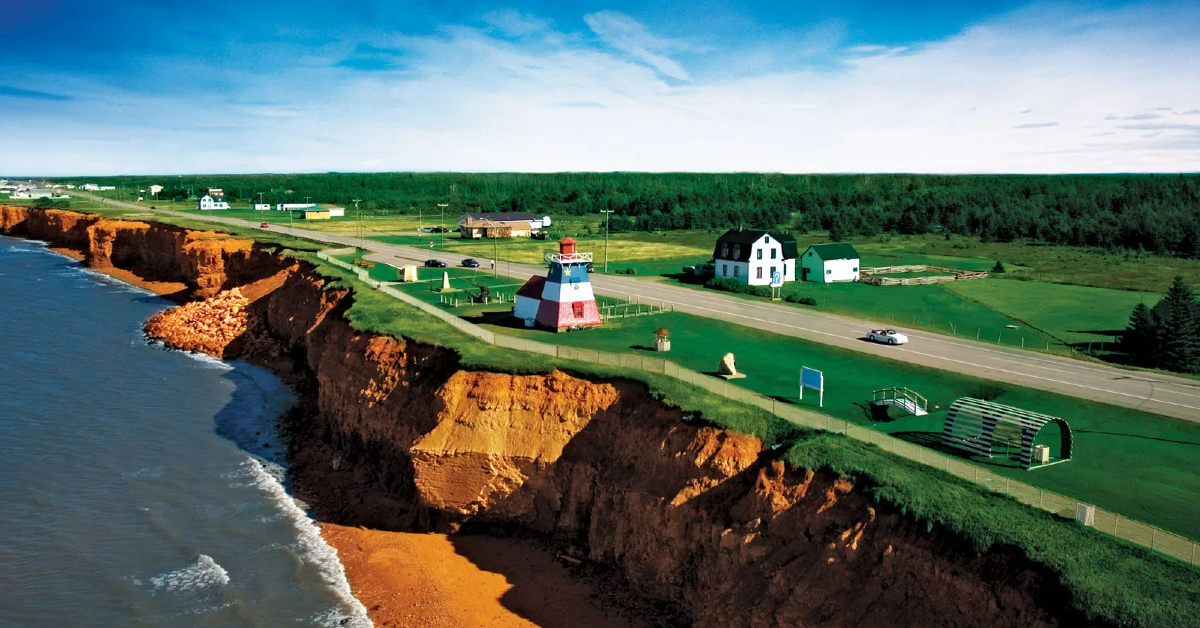New Brunswick Profile
Total Population: ~794,300
% of Ukrainian Population: 1.1% of recent immigrants to New Brunswick were Ukrainian (2016). Larger Ukrainian community post-war.
Language: 58% of population speak English only. 9% speak French only. 33% speak both English and French.
Known For: New Brunswick is the largest of Canada’s three Maritime Provinces. It has 8 cities, 3 distinct coast lines, and has more than 60 lighthouses. It is famous for its inland lighthouse system that dots its inland rivers. New Brunswick is Canada’s only officially bilingual province (English and French).
Pros: New Brunswick has the warmest saltwater beaches in Canada, with over 50 saltwater and freshwater beaches to discover. This province is also famous for its nature. The Bay of Fundy has the highest tides on earth and is one of the most accessible viewing areas for marine life in the world. The Bay of Fundy is also a pristine sanctuary for all kinds of rare, unusual wild creatures. Immense blooms of plankton provide a vast feeding ground for up to 15 species of toothed and baleen whales, including Finbacks, Humpbacks, Pilot whales and the rare right whale. New Brunswick also has many species of birds, with Grand Manan Island in the Fundy Isles being one of the top birding spots in North America. New Brunswick housing prices for renting or for buying are more affordable than any other province. Like many other provinces on the east coast, New Brunswick is known to have very friendly residents, and has a very low crime rate.
Cons: Due to it’s lower population density, New Brunswick doesn’t have much of a night-life scene. Unemployment is also relatively high in the province, as two of the main industries of the province are fishing and agriculture, and these tend to be specialized jobs that require previous experience, and they tend to be seasonal.
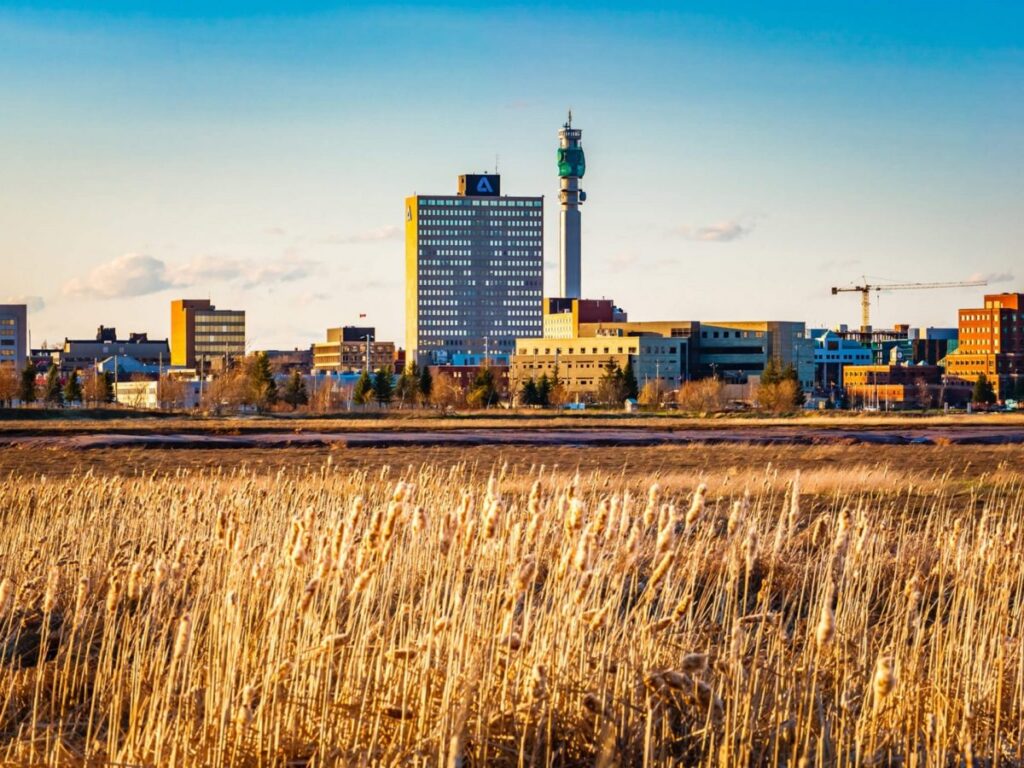
Moncton Profile
Total Population: ~79,000, with a metropolitan population of 158,000
Climate: In Moncton, the summers are comfortable, the winters are freezing and snowy, and it is partly cloudy year round. Over the course of the year, the temperature typically varies from -13 °C to 25 °C and is rarely below -22 °C or above 30 °C.
Known For: The city of Moncton is the second largest city in New Brunswick. Similar to Kherson, Moncton is ocean-side, slow-paced living, no traffic, and a great place to escape the rat race of major cities. It is a dream home for nature and fishing enthusiasts who like a slow and quiet life. This video illustrates more details about life in Moncton.
Pros: Moncton is very family/kid-friendly, and there are many jobs available in forestry, law enforcement, government, teaching, healthcare, and more. Moncton has beautiful saltwater beaches and nature parks. It rests along the Bay of Fundy, which is known for its unique marine life. The Hopewell Rocks, also called the Flowerpots Rocks, are one of New Brunswick’s top attractions — they are rock formations known as sea stacks caused by tidal erosion, standing 40–70 feet tall. Moncton is also the site of Tidal Bore — a naturally occurring phenomenon that creates a thick wave of water that attracts many surfers and spectators.
Cons: Compared to other cities in the province, Moncton tends to have higher rent prices. Moncton is a slower pace of life, so would not be a good fit for those who enjoy fast-paced city life.
Cost of Living: Family of four estimated monthly costs are $4,274.07 without rent. A single person estimated monthly costs are $1,180.88 without rent. Moncton is 4.84% less expensive than Toronto (without rent). Rent in Moncton is, on average, 47.09% lower than in Toronto.
Average cost of rent (1 bdrm): $1,131.25 (2022)
Average cost of rent (3 bdrm): $1,884.62 (2022)
Public Transportation: Codiac Transpo is the main bus service provider in Moncton, with 20 bus routes. Residents have reported that the Green Line offers decent coverage, but the bus system is lacking certain route option. Only certain routes have wheelchair accessible buses.
Arts & Culture: Atlantic Ballet, Capitol Theater, Car Show.
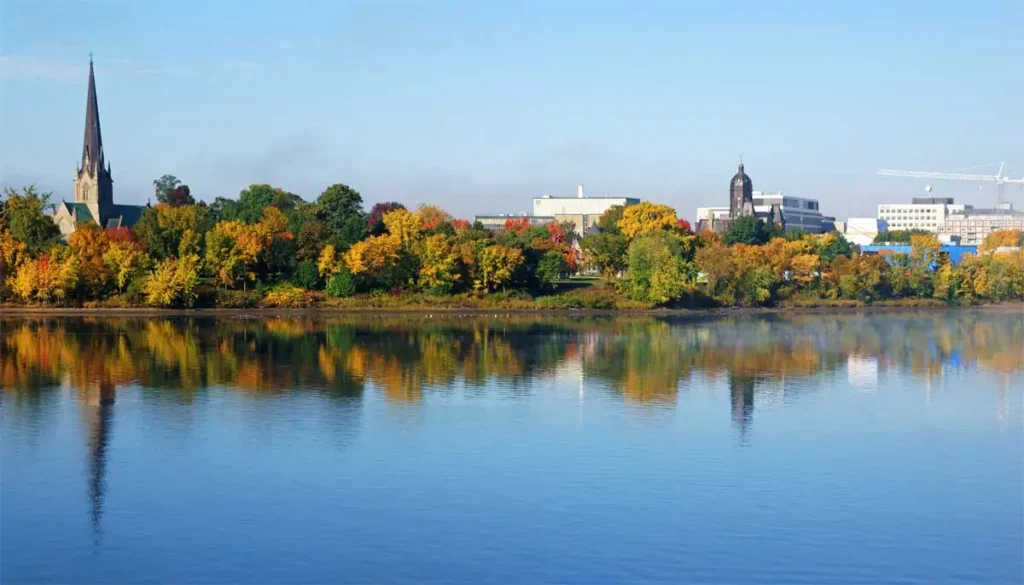
Fredericton Profile
Total Population: ~64,000
Climate: In Fredericton, the summers are comfortable, the winters are freezing and snowy, and it is partly cloudy year round. Over the course of the year, the temperature typically varies from -14 °C to 26 °C and is rarely below -23 °C or above 30 °C.
Known For: Fredericton is the capital city of New Brunswick. It is located in the center of the province and is lined by the Saint John River. Fredericton is the social and cultural heart of the province. It is also known as the ‘city at the edge of nature,’ with 88 kilometers of hiking trails. The city is one of the safest cities in the province.
Pros: Fredericton may be small, but it has a mighty arts and culture scene. Fredericton is home to more working artisans per capita than anywhere in Canada; this can be exemplified by the bustling art markets, galleries and shops found throughout the city. Fredericton is also known as the craft beer brewing town of Canada. The city has the highest concentration of breweries, meaderies and cideries in Atlantic Canada. Kings Landing is a living history open air museum that offers over 40 exhibits.
Cons: Fredericton is the smallest city of the three main settlement locations in the province. Although the city has rich history and culture there is still a lack of diversity in Fredericton. Fredericton experiences exceptionally chilly weather. Cost of living is higher here than other Atlantic Canada provinces.
Cost of Living: Family of four estimated monthly costs are $5,004.99 without rent. A single person estimated monthly costs are $1,374.52 without rent. Fredericton is 8.28% more expensive than Toronto (without rent). Rent in Fredericton is, on average, 49.96% lower than in Toronto.
Average cost of rent (1 bdrm): $1,108.57 (2022)
Average cost of rent (3 bdrm): $1,626.00 (2022)
Public Transportation: Public transport in Fredericton is seriously lacking, especially when compared to other cities of its size and significance, and it is difficult to travel in a timely manner.
Arts & Culture: The city hosts the annual Harvest Jazz & Blues Festival, attracting regional and international jazz, blues, rock, and world artists. Fredericton is known as the “Poet’s’ Corner of Canada”, as the city is the birth place and home of esteemed poets like Bliss Carmen, Sir Charles G.D. Roberts, and Francis Joseph Sherman. Fredericton is also an important and vibrant center point for the region’s top visual artists; many of New Brunswick’s notable artists live and work there today. The Beaverbrook Art Gallery, the provincial art gallery of New Brunswick, is located in Fredericton. The Play House theater and Black Box theater have a number of productions throughout the year, hosting local talent acts and touring performers.
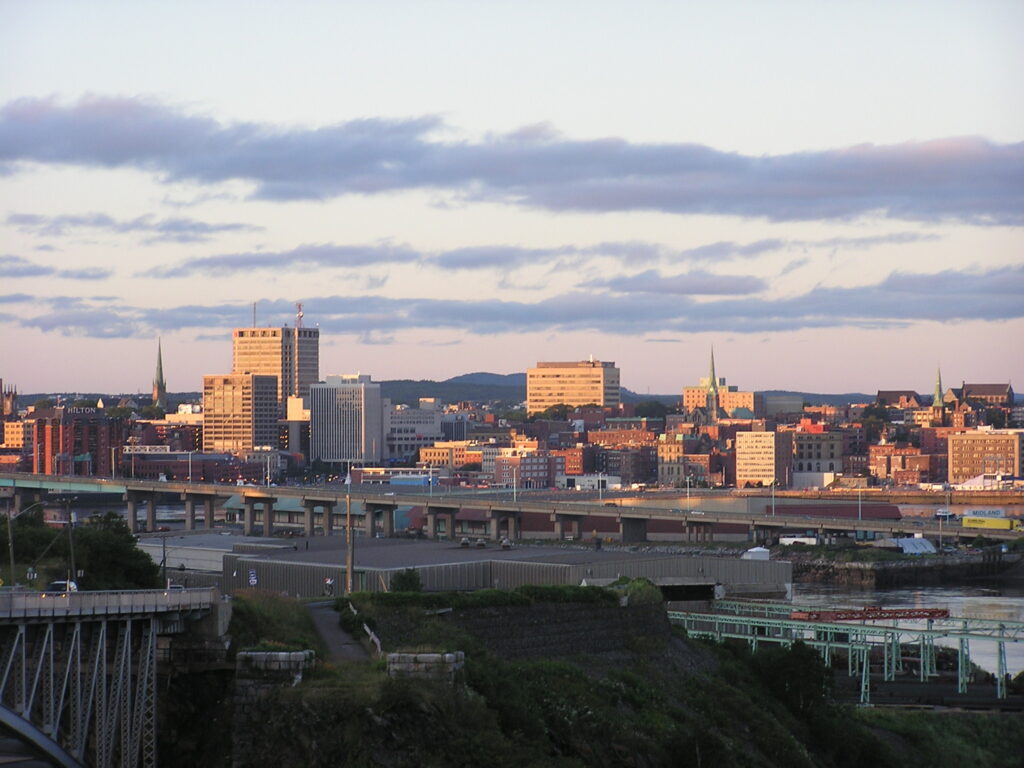
Saint John Profile
Total Population: ~70,000, with a metropolitan population of 206,000
Climate: In Saint John, the summers are comfortable; the winters are freezing, snowy, and windy; and it is partly cloudy year round. Over the course of the year, the temperature typically varies from -11 °C to 22 °C and is rarely below -21 °C or above 26 °C.
Known For: Saint John is the first officially recognized city in Canada. As the only city on the shore of the Bay of Fundy and home to the highest tides globally, Saint John attracts tourists from all over the world. It is the main service center for the province’s offshore oil and gas industry.
Pros: Saint John is New Brunswick’s largest metropolitan city, and it is a port city. The city has one of the most affordable housing in Canada. Residents and people who have passed through St John always comment about the generosity and friendliness of the people. One of the advantages of living in Saint John is that it’s one of the few cities in Canada with moderate weather, even in the thick of winter. Saint John is considered one of the safest places in Canada to raise a family. Residents and visitors cite the togetherness in the various communities, and solid social institutions like Churches, Schools, and Social Clubs contribute to the proper upbringing of children.
Cons: Saint John has the coldest summer season of all the biggest cities in the province. Immigrants and visitors to Saint John have complained of a lack of jobs in the city, so newcomers are likely to struggle for a few months before getting their first job which will most likely be in the maritime industry. Although it has bars, restaurants, and a few lounges, Saint John does not have the nightlife of a bustling city. Most of Saint John’s residents speak either French or English; only a few speak both.
Average cost of rent (1 bdrm): $873.33 (2022)
Average cost of rent (3 bdrm): $1,416.67 (2022)
Public Transportation: Saint John operates the most extensive transportation system in New Brunswick in both coverage and the number of people who use the system. Bus services are provided by the Saint John Transit and Maritime Bus service, which operates in the greater saint john area and the inter-city routes.
Arts & Culture: Saint John is packed with historical architecture. The town boasts plenty of streetscapes, majestic buildings, natural and cultural attractions such as the reversing rapids that mark the point of collision between the bay and the St. John River. The city has a number of art galleries featuring contemporary and nationally recognized Canadian artists. Saint John is also the site of the Area 506 Festival — a celebration of music, culture and goods, right on the Saint John Waterfront. It features a lineup of musical acts, a culture stage, local vendors and family-friendly activities over the New Brunswick Day long weekend.
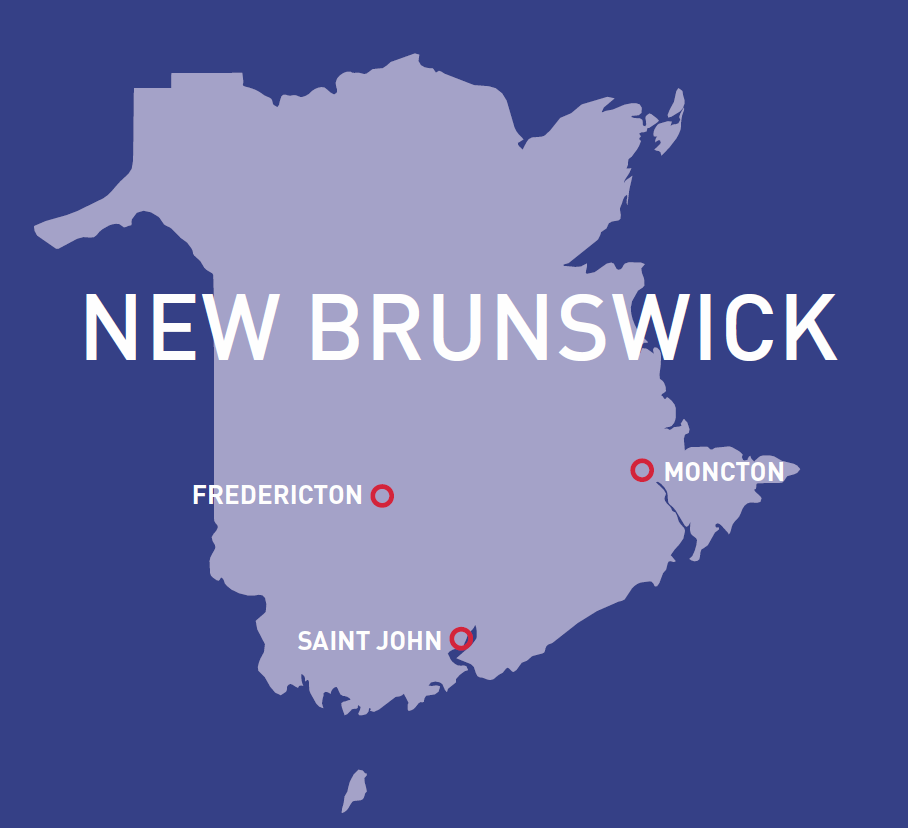
Pre-Arrival
Who to contact to secure housing and migration support: Register at one of the 14 settlement agencies in New Brunswick. These agencies serve different regions of the province. That is why you should register at the agency that serves the region where you found employment or housing. In case you don’t know where you are going to settle within the province, please register at the agency that serves the region of your arrival. Some agencies have a registration form on their website, others require you to email them.
Jobs: New Brunswick Ukraine Initiative Form for Employment Opportunities. This resource is not a job-bank approach. You do not need to browse jobs and apply, but instead just leave your information and Immigration New Brunswick will conduct job-matching and reach out to you with job offers.
Arrival
Airport: Halifax Stanfield International Airport (YHZ). Many fly into Halifax as a major international airport, and take land transport to various locations in New Brunswick.
First Touch-Point:
The Red Cross has a presence at the airport, but in most cases your host sends someone to greet your and pick you up. Charters typically arrange for a custom reception related to that specific flight.
There is also a booth at the airport organized by Nova Scotia’s Labour, Skills and Immigration’s Office of Immigration and Population Growth. The booth typically has coverage from the early morning to late into the evening covering most of the arrival times of the day. It is located just outside the baggage claim hall. The booth has a number of pieces of information available to arrivals regarding different settlement supports available.
First 1-2 Weeks
Temporary Accommodations, Sim Cards & Social Services:
Register in advance at one of the 14 settlement agencies in New Brunswick. You can also contact:
Moncton
Ukrainian Club of Moncton
Facebook Page: Ukr Club Moncton
Fredericton
Ukrainians of Fredericton
Email: ukrainians.of.fredericton@gmail.com
Facebook Page: Ukrainian Community of Fredericton
Saint John
Ukrainian Association of Saint John
Email: info@uasj.ca
Facebook Page: UA Saint John
Settlement
WELCOME/INFO PACKS:
Accommodations (longer term), Jobs, Childcare, Education, Language Support, etc.
- Welcome Kit (UKRAINIAN)
- Welcome Kit (ENGLISH)
Additional Information
Resources for Ukrainian Newcomers (IKRAINIAN & ENGLISH)


